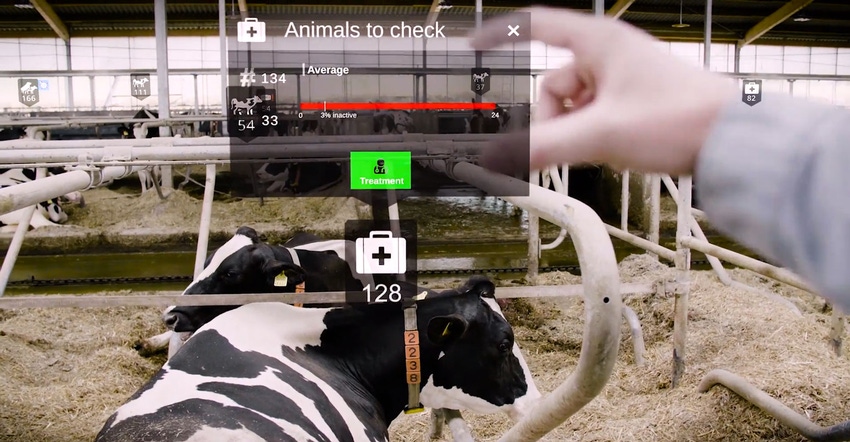
Picture this scenario: It’s time to do a herd check on the cows. You finish up the remaining chores and head out to the free-stall barn. One cow, No. 225, has a severe case of mastitis and you’re keeping a close eye on her.
You get your goggles on and head into the barn. You gently say “225” as if talking to someone walking aside of you. Within a second, a green arrow points the way to cow 225. She’s in the other end of the free-stall barn.
The arrow didn’t come down from the rafters; rather, it shows up right in front of you courtesy of those goggles you have on.
Now that you have located 225 you probably want to know how her last milking went. You say, “last milking.” Within a second, all the information on 225’s last milking comes up — how much she produced, average production for the day or week, her eating behavior and more.
This is what’s possible when you have a cow management system linked to augmented reality. Nedap, a Dutch multinational company, thinks this could be the future of cow monitoring systems. It debuted its dairy AR system for the first time in the U.S. at World Dairy Expo.
High-tech monitoring
Visitors at expo got to test the system using a pair of Microsoft Hololens goggles that were linked to a fake cow with a monitoring collar attached.
Looking into the goggles was nothing special until you were looking directly at the cow itself. Just above the cow was a plethora of information about its heat status, production history, health and more displayed in a “virtual cow card.” Navigating through the menus on the card is easy; all you do is “push” a button or say what you want to look at it — the voice recognition works really well.
So, where does all that cow data come from?
“This augmented reality is our latest innovation and latest add-on to our activity monitoring system, which we call Nedap CowControl," said Rudy Ebbekink, Nedap livestock management.
CowControl works using smart tags attached to each cow’s collar or foot. The system can track anything from heat signals and health to how much a cow has eaten and its inactive behavior. CowControl includes a cow locating system that can pinpoint exactly where a cow is at on the farm. Data collected is normally delivered to a farmer’s smartphone or computer where they can remotely see what’s going on in the barn, but with AR goggles the data is brought to a farmer’s field of vision.
 HI-TECH MONITORING: Microsoft Hololens goggles allow Rudy Ebbekink to demonstrate how to use Nedap’s dairy augmented reality system on a farm.
HI-TECH MONITORING: Microsoft Hololens goggles allow Rudy Ebbekink to demonstrate how to use Nedap’s dairy augmented reality system on a farm.

“So, we actually combine the real field of vision when the farmer walks the barn with digital information, and it's not only that, but we also are able to pinpoint the information exactly above the cow it concerns," he said.
It took two years for the company to develop the technology, Ebbekink said. It was first debuted in late 2018 at EuroTier in Germany.
Not for sale, yet
Showing off technology at a trade show is one thing; seeing it work on farms is another thing entirely.
Ebbekink said the company is still in the development stage of the program, and it could be a while before dairy farmers are able to use it.
For one thing the company hasn’t finalized what type of goggles it will use to launch its AR platform. While the Microsoft Hololens goggles are good for demos, Ebbekink said the company is waiting on a newer version of the goggles that will be more robust with better battery life and a wider field of vision.
Selling farmers
The bigger question the company must answer is how it plans to sell dairy farmers on using AR technology. Getting farmers to test it out for themselves will be key.
Initial tests on farms, he said, were met with comments about how silly the goggles looked, but the conversation quickly changed once farmers put the goggles on.
 SMART TAGS: The dairy AR system is made possible using smart tags on cows, such as these tags on this display cow at World Dairy Expo.
SMART TAGS: The dairy AR system is made possible using smart tags on cows, such as these tags on this display cow at World Dairy Expo.

“When they wear the goggles and they see all that information about their cows that is relevant when they walk around in that place, then they slowly start to say, ‘Oh well, this is actually not as weird as it looked like from the outside,’ and they really see the value of that,” he said. “Luckily, it’s really an intuitive way of consuming all that herd data. You use your voice, you use hand gestures as you would in the normal life and it really is an intuitive way of consuming that information.”
AR vs. VR
You might be wondering what the difference is between augmented reality and virtual reality (VR).
Well, if you ever heard of Pokemon Go — more than likely your children or grandchildren have heard of it or played it — or Snapchat, this is AR. It essentially adds digital elements to a live view by using the camera on a smartphone.
VR is a more immersive experience that shuts out the physical world around you. So, if you put on a pair of VR goggles and it feels like you’re in the middle of a video game, that’s virtual reality.
About the Author(s)
You May Also Like






